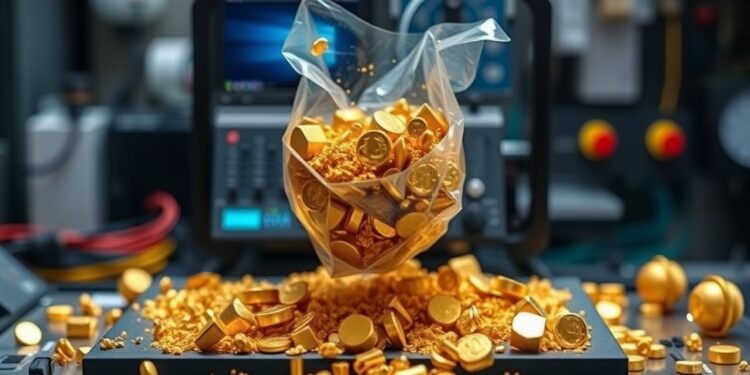
A groundbreaking innovation from a Cornell University-led research team is opening new avenues in the field of waste management and sustainable chemistry, particularly focused on the lucrative potential of electronic waste, or e-waste. This revolutionary method not only addresses the environmental concerns associated with e-waste but also leverages the precious metals found within discarded electronics for catalytic conversion of carbon dioxide (CO2). With the alarming rate of e-waste generation, estimated at around 50 million tons annually, it is imperative to explore sustainable solutions that can yield valuable resources while mitigating ecological harm.
The intricacies of this new method are rooted in the synthesis of novel vinyl-linked covalent organic frameworks (VCOFs) developed by Amin Zadehnazari, a postdoctoral researcher in Professor Alireza Abbaspourrad’s lab. These frameworks have demonstrated remarkable efficacy in the selective extraction of gold from electronic devices. In fact, Zadehnazari’s pioneering work has proven that these VCOFs can capture over 99.9% of gold while leaving behind less than trace amounts of accompanying metals, such as nickel and copper. This stark selectivity not only enhances the efficiency of gold recovery but also underscores the potential of VCOFs in minimizing environmental contamination during the extraction process.
The significance of gold recovery from e-waste cannot be overstated. It is estimated that one ton of e-waste contains at least ten times more gold than one ton of ore mined through traditional means. As global consumption of electronics continues to surge, the urgent need to address the increasing stockpile of e-waste coupled with the quest for gold recovery takes on heightened importance. By advancing this e-waste recycling method, researchers are not only capitalizing on the untapped resources found in discarded electronics but are also offering a sustainable pathway to manage e-waste which currently sees approximately 80% left unrecycled.
Traditional methods of gold recovery have relied heavily on the use of toxic chemicals such as cyanide—a process fraught with environmental and health risks. The innovative method proposed by Zadehnazari and his team, however, circumvents the need for harmful chemicals by employing chemical adsorption techniques. This involves the adhesion of gold ions and nanoparticles to the surface of the VCOFs, effectively facilitating gold extraction in a way that is both environmentally friendly and technologically advanced.
Once the gold is recovered, its application takes a transformative turn. The loaded VCOFs serve as catalysts in the conversion of CO2 into valuable organic chemicals. This dual benefit of recycling e-waste while simultaneously addressing greenhouse gas emissions positions this research at a critical intersection of environmental sustainability and practical utility. Zadehnazari explains that by transforming CO2 into valuable materials, the research team is not just innovating in waste management; they are also contributing to broader climate action efforts.
The broader implications of this work underscore its potential impact on industries ranging from electronics to chemicals. With the ability to recycle gold in a manner that is clean and efficient, industries can minimize their environmental footprints and contribute positively to the circular economy. As Zadehnazari notes, this novel approach to e-waste does not merely reduce waste disposal demands; it embodies a holistic solution that intersects environmental benefits and economic viability, heralding a “win-win” scenario.
The research represents a collaborative effort, utilizing the advanced facilities at Cornell, including the Cornell Center for Materials Research and the Cornell NMR facilities, both funded by the National Science Foundation. This underscores the importance of interdisciplinary partnerships in solving complex environmental challenges—merging expertise from materials science, chemistry, and environmental engineering to forge innovative solutions.
The study detailing these findings was published in the prestigious journal Nature Communications, attracting attention from various scientific communities interested in waste recovery technologies and sustainable chemistry. The article titled “Recycling E-waste Into Gold-loaded Covalent Organic Framework Catalysts for Terminal Alkyne Carboxylation” emphasizes the significance and novelty of the methodology. By sharing this knowledge with the global scientific community, researchers hope to inspire further innovations and research into similar sustainable practices across different fields.
Overall, the work carried out by Zadehnazari and Abbaspourrad’s team signifies a pivotal step towards more responsible practices in managing e-waste. It serves as a reminder that solutions to global challenges often lie in the repurposing of waste materials into valuable assets. As technology continues to advance and e-waste continues to accrue, methods like this one represent hope for a more sustainable future—where waste is minimized, resources are maximized, and ecosystems are preserved.
In conclusion, as society grapples with the mounting challenges of climate change and environmental degradation, innovations such as this e-waste gold recovery process pave the way towards sustainable progress. Such research not only provides concrete answers to pressing problems but also offers a glimpse into a future where technology, ecology, and economic interests harmoniously coexist. The importance of disseminating this information cannot be overstated; as awareness grows, so too does the potential for widespread adoption of sustainable practices that will benefit both humanity and the planet.
Subject of Research: Sustainable recovery of gold from electronic waste and its application in catalyzing CO2 to organic materials.
Article Title: Recycling E-waste Into Gold-loaded Covalent Organic Framework Catalysts for Terminal Alkyne Carboxylation
News Publication Date: 30-Dec-2024
Web References: Cornell Chronicle Story
References: DOI 10.1038/s41467-024-55156-3
Image Credits: (Information not provided)
Keywords
E-waste, Gold recovery, Covalent organic frameworks, Sustainable chemistry, CO2 conversion, Environmental sustainability, Waste management, Chemical adsorption, Catalysts, Greenhouse gas emissions, Circular economy, Toxicity in mining.





